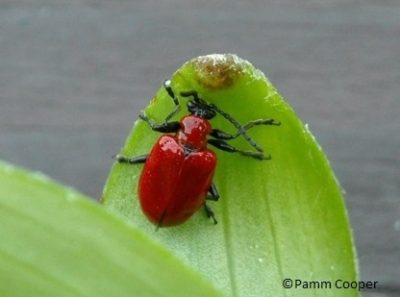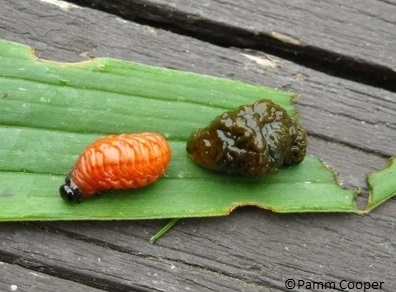Lilioceris lilii
The Lily leaf beetle (LLB) is a Eurasian pest that was brought to North America through Canada in the 1940’s and was first found in the United States in Cambridge, Massachusetts in 1992. This bright scarlet beetle is a serious pest of native and exotic lilies causing economic and aesthetic losses for commercial growers and home gardeners. It is believed that the LLB came to North America with bulbs that were shipped from Europe. Gardeners who are transplanting bulbs and other garden plants should be careful not to move these beetles to un-infested areas.
Description
The lily leaf beetle is sometimes confused with the cardinal beetle (Pyrochroa serraticomis) as they both have black undersides and wings that are spotless and red. However, the LLB wing cases are shinier with tiny dimples and they are more rounded than the dull long and flattened cases of the cardinal beetle. Adult lily leaf beetles are 6 to 9mm (1/4 to 3/8”) long. Lily leaf beetles fly very well. When disturbed or squeezed they make a squeaky noise to deter predators.

Habits and Life Cycle
The lily leaf beetle is known to lay its eggs and develop only on true lilies (Lilium species) and fritillaria (Fritillaria species) and other members of the family Liliaceae. Secondary minor hosts may include lily of the valley (Convallaria majalis), Solomon’s seal (Polygonatum species), bittersweet (Solanum species), potato (Solanum tuberosum), hollyhock (Alcea) and various hosta species. The adult LLB will over-winter in the ground and emerge late March through June to feed. The adults prefer environments that are shaded, protected, cool and moist. The adult beetles will lay their eggs in groups of about 12 on the undersides of the leaves, usually in May. The female beetle will lay up 450 eggs over two growing seasons. The eggs are reddish-orange and will darken over the next 7-10 days before they hatch.

The larvae initially feed on the underside of the foliage but will move to the upper surfaces of the leaves and buds. The larvae resemble slugs and their bodies can be orange or brown with some yellow or green. The heads are black. The LLB larvae can be difficult to eliminate as they carry their frass (excrement) on their backs and this forms a barrier of sorts against pesticides. After 16-24 days the larvae will enter the soil to pupate. The pupae are florescent orange. New adults emerge in 16-22 days and they will feed until fall. This generation will not mate or lay eggs but will overwinter in the soil or plant debris.

Both the larvae and adults attack all aboveground plant parts and can entirely defoliate a plant resulting in a loss of vigor for the plant. The damage to the leaves and flowers can leave the plant weakened and susceptible to diseases such as Lily grey mold (Botrytis elliptica).
Control
Hand-picking adults and eggs can be done if the infestation is not large. Be sure to turn over leaves to look for the egg masses. The insecticides carbaryl (Sevin) and malathion are effective on adults and larvae. However, carbaryl is highly toxic to bees and malathion is also toxic to many non-target insects. A safer method is to use neem, an insecticide based on the extracts from the neem tree. Neem will kill the larvae and repel the adults but it must be applied every 5-7 days after the eggs hatch. Imidacloprid, which is a systemic, is also effective although it is suspected of contributing to colony collapse disorder in bees.
Planting Asian lilies in containers may minimize the scourge of the LLB as they can be repotted and/or moved to new locations each year. This method does not allow the adults to overwinter in the soil beneath the plants, breaking the life cycle.
There are no natural enemies of the beetle in North America. The LLB is under control in Europe due to six species of parasitoids: five wasps and a fly. Of these, four were identified as potential candidates for introduction in the United States. Many states are currently running biological control projects using the parasitoids.
Despite good cultural practices, pests and diseases at times may appear. Chemical control should be used only after all other methods have failed.
For pesticide information or other questions please call toll free: 877-486-6271.
Revised by UConn Home and Garden Education Center 2016.